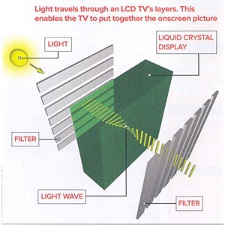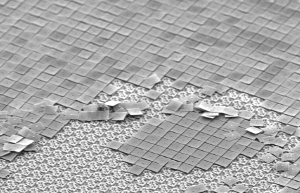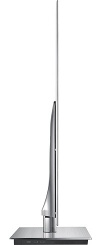Plasma, LCD, DLP, LED - Which is right for me?
The battle between LCD and Plasma display technologies has been raging for several years, with many tech fans divided between the two camps. The good news is that average
consumers can understand the basic differences between LCD and Plasma televisions and in the current market there are good options in both categories so with a little information
you cannot go wrong.

LCD Displays
LCD TVs are, in terms of raw sales figures, the most popular display type on the market. They can range in size from around 15 inches across the diagonal right up to 55 inches
or more, depending on the make and model. LCD stands for liquid crystal display and in short the onscreen image is produced by shining light through a pair polarized filters on either
side of a network of microscopic crystals. This, along with electronic signals determines the color of each pixel. This process is replicated millions of times in order to form the
entire picture that is to be displayed on the screen. This entire process is repeated for each frame, usually 30 or 60 times per second.

Plasma Displays
Plasma TVs are traditionally larger than LCD screens, starting at around 40 inches and going up to 60 inches or more. This is because it is impractical to make smaller screen
sizes as a result of the technology behind the displays. Rather than crystals Plasma TVs uses minute gas chambers sandwiched between sheets of glass. Electricity acts upon the
gas to create light which then passes through RGB dots and results in the onscreen image.
Plasma TVs are typically favored by cinema enthusiasts not only because of their large size but also because they produce better contrast ratios, which means the dark area of
an image will be more distinct from a light area and as such blacks will be deeper while whites remain crisp. LCD manufactures have worked hard over recent years to reduce the
difference and the results have been successful but cheaper screens will be inferior to a high quality Plasma set, as you might have imagined.
LED Displays
Because of the technology inside a Plasma TV it will be much heavier and slightly thicker than a standard LCD alternative. LCD TVs are also more energy-efficient than Plasma
televisions, which may be a concern if you are looking to cut down on your carbon footprint. If you want superior energy efficiency that tops standard LCD screens then opt for
an LED TV. These ditch the traditional fluorescent backlighting options in favor of using thousands of tiny LEDs (light emitting diodes) and these not only waste less energy
as heat but they also take up less space, resulting in ultra-thin televisions that look very space-age. Using LEDs to light an LCD screen improves contrast ratios as well;
However, some displays will be edge lit only, while others will have LEDs across the entire area of the screen. Edge lit screens can potentially have uneven lighting, although
reputable manufacturers usually address this issue and make it unnoticeable.
DLP Displays
A final type of display technology is on offer in today`s market. DLP (Digital Light Processing) TVs use rear-projection technology and are based on the same techniques used in many standalone home cinema over-head projectors. They can be cheaper than the Plasma or LCD alternative and give great picture quality but their thicker nature means that they will not be as aesthetically appealing as their rivals. DLP TVs work by using a small DLP chip which contains a rectangular array of up to 2 million hinge-mounted microscopic mirrors. These micromirrors each measures less than one-fifth the width of a human hair. The micromirros either tilt towards the light source to create a light pixel on the projection surface or away from the light source in order to create a dark pixel on the screen. The white light generated by the lamp passes through a color filter and on to the surface of the DLP chip. With BrilliantColor™ Technology additional colors, Cyan, Magenta and Yellow, are added to the traditional red green and blue to add even more vibrant color performance. As a result some of the top of the line DLP projectors are capable of producing up to 35 trillion colors. Which ever technology you decide on I'm sure that any of these screens will be great to recline in front of in a Berkline home theater chair and enjoy your favorite movies.

A DLP chip shown in comparison with a pencil.

A small section of a damaged DLP chip viewed under an electron microscope.

An illustrated example of how a DLP TV or projector displays images on screen.
Some other points of intrest that may help influence your decision:
High Altitude
If you live in a high altitude location you will probably be best off getting a LCD TV. Higher altitudes are more strenuous on Plasma TVs because the thinner air cause more stress on the rare natural gasses inside the TV. The pressure does not affect the LCD display. Because of this many airlines install LCD display in their airplanes. If you do decide you want a Plasma TV and live in a high altitude region be sure that the TV you decide to purchase is rated for high altitude use.
Burn-in Effect
One disadvantage of plasmas to consider is the burn-in effect. Plasma TVs are susceptible to burn-in. If a stationary image is left on the screen for too long it can become “burned in” to the screen leaving an outline of the previous image. A common example is network logos. Newer Plasmas are not as bad as previous generations and burned in images can even come out over time, but this is something to think about if you plan on leaving the TV on with the same image constantly displayed on the screen.
Use With Computers
If you often use your TV to display images from your computer, LCD screens can easily and effectively render the static images often produced by PCs without any worry of possible burn-in.
Power Consumption
LCDs have much lower power requirements than a comparable Plasma counterpart and LED TVs typically use even less electricity than a comparable non LED HDTV; therefore an LED-LCD is usually the best choice in terms of power consumption.
Wide Angle Viewing
If you plan to have people viewing your TV from extreme angles (left, right, above or below) you may want to consider a Plasma TV or an adjustable mount since tend to have a slightly larger viewing angle.
Want more information on how each technology works? Below are some informative videos describing how each technology works.
